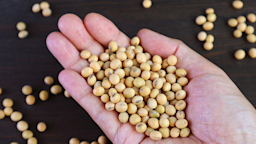Key takeaways:
Seed cycling is the practice of eating specific types of seeds during different phases of a menstrual cycle.
Seed cycling advocates claim that it helps balance hormones and helps with fertility, premenstrual syndrome (PMS), and irregular periods.
There’s no solid evidence that seed cycling helps balance hormones or relieves symptoms associated with changing hormones.
You may have heard the hype about seed cycling, which involves eating certain seeds at different times during a menstrual cycle. This practice claims to help balance hormones, boost fertility, and ease symptoms of premenstrual syndrome (PMS) and menopause. But does it work?
Here, we’ll dive into the science behind this claim and provide a deeper look at whether seed cycling can really help.
What is seed cycling?
Seed cycling is a holistic method used to help balance hormones during a menstrual cycle. It involves eating specific seeds during two main phases of your menstrual cycle. The goal is to promote a healthy balance of estrogen and progesterone. In other words, seed cycling is a way of trying to influence your hormones through diet.
Seed cycling advocates claim that it relieves hormone-related issues such as:
PMS
Polycystic ovary syndrome (PCOS)
Irregular periods
Hot flashes
Some people also believe that seed cycling can help you get pregnant and manage other hormonal symptoms like acne.
How to seed cycle
A typical seed-cycling protocol involves eating 2 tbsp of ground seeds every day. These seeds include:
You can blend these seeds into a smoothie, sprinkle them on oatmeal or yogurt, or eat them on their own. Some people insist that the seeds must be raw and freshly ground, while others aren’t as strict.
Feeling tired on your period? Here are some ways to manage menstrual fatigue.
Stress can cause changes to your period: Find out how stress affects your menstrual cycle and what you can do about it.
Should you change your diet for your period? Some foods can either worsen or improve your menstrual symptoms.
Here’s a commonly recommended seed cycling regimen:
Phase one: This involves the follicular phase and occurs during the first 2 weeks of your menstrual cycle. The protocol is to eat 1 tbsp each of flax and pumpkin seeds every day.
Phase two: This involves the luteal phase and is the last 2 weeks of your menstrual cycle. During this phase, you switch to eating 1 tbsp each of sunflower and sesame seeds.
Does seed cycling come with any risks or side effects?
There’s no known harm in trying out seed cycling, unless you’re allergic to any of the recommended seeds. The seeds are a good source of:
Fiber
Plant-based protein
Vitamins
Minerals
Antioxidants
Read more like this
Explore these related articles, suggested for readers like you.
These nutrients are a part of a balanced diet, and it’s a good idea to include a variety of them in your diet on a regular basis.
Where did the idea of seed cycling come from?
The thought behind seed cycling is that eating pumpkin and flax seeds during the first half of the menstrual cycle can help prevent excess estrogen from building up and promote “normal” levels. This is because these seeds contain lignans. These are a type of phytoestrogen, or plant compound, that mimics the structure of estrogen. Flaxseeds are particularly rich in lignans. They have about 100 times more lignans compared to other lignan-containing foods.
Lignans may help ease the symptoms of menopause. But lignans have mostly been studied for their anticancer properties — not on hormone balance during a menstrual cycle.
In the second phase of your menstrual cycle, sesame seeds and sunflower seeds are believed to boost progesterone production. They’re also rich sources of zinc, vitamin E, and selenium, which support a healthy reproductive system. There’s limited scientific evidence to confirm any effects on PMS or other symptoms.
Does seed cycling work?
It’s hard to say. There’s very limited research on the practice of seed cycling. An old study from 1993 reported that consuming lignans from flax seeds had no significant influence on estrogen concentrations during the follicular (first) or luteal (second) phases. And a more recent review concluded that there’s not enough evidence to suggest it works.
Similarly, micronutrients like magnesium, zinc, and vitamin E are helpful for a healthy reproductive system. However, there’s no solid evidence that getting these nutrients through seed cycling offers any extra benefits for hormone balance.
So should you try seed cycling?
Seed cycling isn’t proven to support female hormone balancing. It’s also not proven to relieve any of the symptoms linked with changing hormones.
As mentioned, the seeds involved have many health benefits. If you experience benefits from seed cycling, it could be from the addition of nutritious foods like seeds into your diet and not necessarily the act of seed cycling itself.
Ultimately, the decision to try seed cycling is an individual one. It’s always best to talk with a women’s health professional if you’re concerned about hormone imbalances. They can offer evidence-based advice and recommend any testing, if needed.
Frequently asked questions
There isn’t enough data to suggest how long seed cycling should last. Without proper studies on the matter, it’s impossible to say what the best length of time for seed cycling should be.
It’s unclear. Some say that a few consecutive months of cycling is enough time to begin seeing the benefits. Without quality human studies on seed cycling, there’s no evidence to support any claims on seed cycling length or efficacy.
There isn’t enough data to suggest how long seed cycling should last. Without proper studies on the matter, it’s impossible to say what the best length of time for seed cycling should be.
It’s unclear. Some say that a few consecutive months of cycling is enough time to begin seeing the benefits. Without quality human studies on seed cycling, there’s no evidence to support any claims on seed cycling length or efficacy.
The bottom line
Seed cycling is the practice of trying to influence hormones by eating sesame, pumpkin, flax, and sunflower seeds. Advocates claim it can help with fertility, irregular periods, or PMS. But there’s no solid evidence to suggest it works or affects hormone levels. It’s best to discuss your concerns with your primary care provider or a woman’s health specialist, who can help you with the next steps.

Why trust our experts?



References
Calado, A., et al. (2018). The effect of flaxseed in breast cancer: A literature review. Frontiers in Nutrition.
Favier, A. E. (1992). The role of zinc in reproduction: Hormonal mechanisms. Biological Trace Element Research.
Jang, W. Y., et al. (2022). Antioxidant, anti-inflammatory, anti-menopausal, and anti-cancer effects of lignans and their metabolites. International Journal of Molecular Sciences.
Mahapatra, D., et al. (2023). Advantages of seed cycling diet in menstrual dysfunctions: A review based explanation. The Pharma Innovation Journal.
Phipps, W. R, et al. (1993). Effect of flaxseed ingestion on the menstrual cycle. Journal of Clinical Endocrinology and Metabolism.
Sicilia, T., et al. (2003). Identification and stereochemical characterization of lignans in flaxseed and pumpkin seeds. Journal of Agriculture and Food Chemistry.
Traber, M. G. (2014). Vitamin E inadequacy in humans: Causes and consequences. Advances in Nutrition.

















